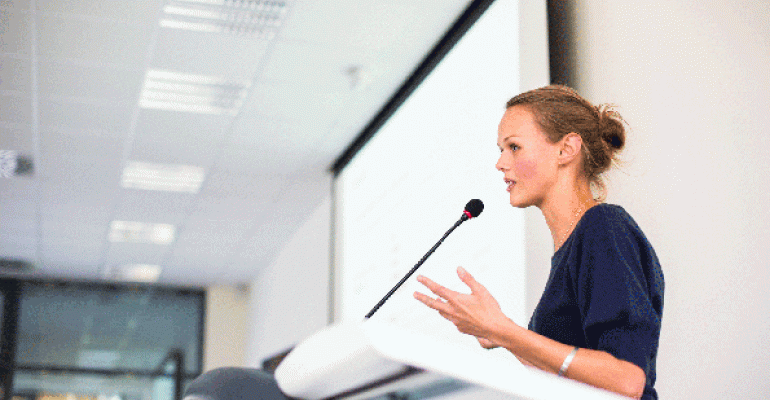 Wouldn’t it be great have docs at your continuing medical education activities raving about how lucky they were to have come to your session, and how tragic the missed opportunities were for those who weren’t there? The one thing that they’ve seen push it over that threshold is having a person who lives every day with the disease under discussion share the stage, said presenters at a session on patient-centric education at this year’s Alliance for the Continuing Education of Healthcare Professionals, held earlier this year in National Harbor, Md.
Wouldn’t it be great have docs at your continuing medical education activities raving about how lucky they were to have come to your session, and how tragic the missed opportunities were for those who weren’t there? The one thing that they’ve seen push it over that threshold is having a person who lives every day with the disease under discussion share the stage, said presenters at a session on patient-centric education at this year’s Alliance for the Continuing Education of Healthcare Professionals, held earlier this year in National Harbor, Md.
In a wide-ranging, often heartfelt discussion, the presenters—Steve Bender, president, FACTORx; Derek Dietze, MA FACEHP, president, Improve CME LLC; and Suzanne Schrandt, JD, Patient-Centered Outcomes Research Institute—explored how the Rheumatoid Arthritis: Primary Care Initiative for Improved Diagnosis and Outcomes, or RAPID, continuing medical education initiative has evolved to include more of the patient perspective.
One of the most striking moments of the session was the description of how a simple conversation with a patient during a slide review turned into a message that shaped the initiative for the next six years.
The RAPID CME Patient Experience
The RAPID CME initiative was launched in 2007 to help primary care physicians learn to identify patients with early RA using simple screening tests and appropriate lab tests, to treat both new and established RA patients with appropriate therapies, and to co-manage treatment with rheumatologists and other specialists. The initiative also wanted these physicians to understand what their patients live with by having the docs experience the manual dexterity issues their RA patients face.
The initiative used a mixture of formats, from live symposia with hands-on diagnosis workshops, live grand rounds, print pieces, provider and patient mobile apps, and online enduring materials, journal supplements, newsletters, a pocket reference guide, and patient education materials.
When the chair asked about involving a patient advocate in the initiative, the faculty initially pushed back, said Bender—as in “What’s the patient going to tell me?” Then, Bender explained, “we asked him if he’d ever been on biologic A, B, or C—and he got over the attitude.” In 2008, the initiative’s organizers began using patients as faculty at the live symposia.
Within a year, that role expanded to patients participating on the content development planning committee, and serving as faculty for enduring activities and patient apps as well as live symposia.
Use Patient Experience to Inform CME
The initiative’s designers also asked its patient advocate to use her experience to help design using an RA glove that would simulate what it’s like to live with the condition. Physicians then would put on the glove and attempt to do everyday tasks.
Schrandt, who was diagnosed with RA as a teenager and served as the initiative’s patient advocate, said that the gloves really drove home what patients go through. “We had them try to turn a key in a lock, and do things I can’t do because they’re too messy, like peel back the foil top on a yogurt container.”
To illustrate how important it is to diagnose and treat RA promptly, the initiative included a slide that showed the progression of the disease from someone who had prompt treatment with the appropriate therapy to someone diagnosed 50 years ago with none of the currently regarded best therapy. The differences illustrated on the slide, which the presenters included in their ACEhp session, were dramatic and impossible to ignore.
But it was a chance conversation during a slide review that really drove home the importance of including a patient advocate. Schrandt mentioned how her pharmacist, seeing the sunscreen and flipflops she had picked up for a spring break trip, advised her about the photosensitivity the drugs she was on would cause.
“It was an eye-opener,” said Bender. “She’s in rural Kansas, so she knows her pharmacist because she sees the same person every time. That was unheard of for our urban physician faculty,” whose patients aren’t likely to have that type of personal relationship with their pharmacist. This made the activity organizers think about what other aspects of the practices and patient circumstances of the than 64,000 primary care physicians educated under the initiative may be other than what faculty may be assuming.
The Patient Advantage
“Clinicians line up to talk with me and get honest answers. Because I’m not their actual patient, the pressure is off,” said Schrandt.
But, the presenters warned, remember that, while they can add a lot of value for the learners, it’s not an easy experience for the patient advocate. “When you’re talking about diarrhea in front of 500 people…well, it gets personal,” said Schrandt. “I was prepared for it and knew what to expect; be sure to find patients who are willing to be that open, and make sure they’re prepared.”
And as Dietz reminded those in the room, “We are patients too. We should use our experience as patients to inform our programs.”



